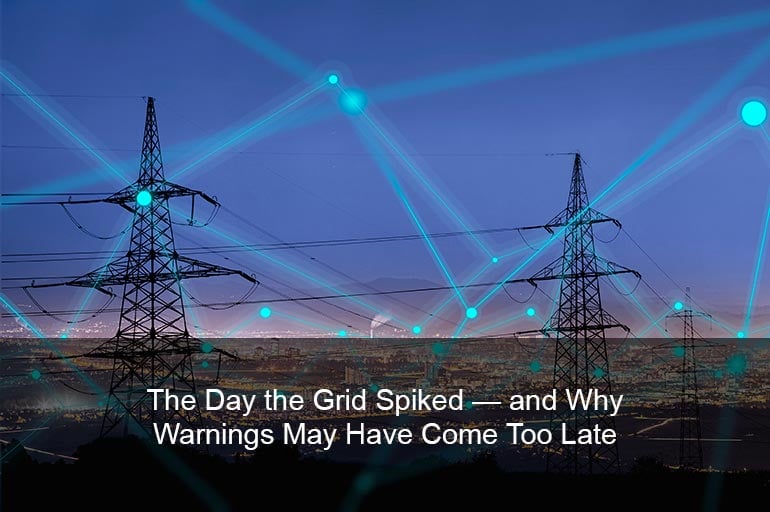Before GPS, we planned trips with paper maps. You knew where you were starting, and where you wanted to end up, but not much in between. You couldn’t see traffic. You didn’t know the fastest route in real time. And if conditions changed, your only option was to wing it and hope for the best.
That’s how most facilities still manage their energy systems today.
They know their equipment. They have historical data. Some even maintain centralized dashboards or partake in demand response or peak shaving efforts. But they can’t necessarily see what’s coming. Their reaction time is delayed, resulting in missed savings opportunities.
The importance of integrated predictive analytics cannot be overstated, especially as rising data center demand drives up capacity and transmission costs across the grid.
If you’re stuck paying higher utility rates after they’ve gone up, if your backup systems only get used a few dozen hours a year or if surprise peak charges show up on your bill months later, you’re operating in the forecast gap—and it’s costing you a lot.

Closing the Energy Forecast Gap
When applied effectively, predictive analytics can do more than optimize performance—it can change how infrastructure delivers value to the business.
Most organizations have three major opportunities for improvement:
- Energy costs saved through smarter load coordination
- Grid flexibility dollars earned through advanced predictive demand response
- Peak price costs avoided through proactive load shifting
Let’s break these down.
1. Energy Costs Saved: Smarter Load Management & Asset Optimization
Facilities are loaded with energy-consuming systems: boilers, chillers, pumps, fans, batteries and generators. Most operate in silos, using static schedules or operator judgment to determine run times.
That means:
- Equipment often runs when it shouldn’t
- Loads overlap inefficiently (e.g., simultaneous heating and cooling)
- Operators lack the real-time insight to make precise decisions
- Energy is used reactively—not strategically
Predictive load forecasting changes all of this. Instead of operators needing to make predictions, the system looks ahead at forecasted utility loads, weather, occupancy, even carbon intensity, and using the information gathered decides which equipment should run, when and how hard to run it. The result is simple but powerful: a system that optimizes assets to forecasted conditions—delivering measurable savings without costly equipment upgrades.
2. Grid Flexibility Dollars Earned: Smart Demand Response and Predictive Virtual Power Plants (VPPs)
The majority of demand response programs rely on delayed utility signals and limited visibility into coming peaks, which means that assets are only used 20 to 100 hours per year, leaving money on the table.
With advanced predictive analytics, it’s possible to forecast grid needs, market conditions and site performance in real time. Rather than waiting to respond to signals, facilities can position themselves as flexible, revenue-generating participants in the grid, unlocking hundreds of hours per year of monetizable availability.
Depending on the market, systems can earn hundreds of thousands of dollars per megawatt per year through demand reduction and grid services without disrupting core operations. Demand response no longer has to be a side hustle. With predictive capabilities, it becomes a core financial strategy.
3. Peak Price Costs Avoided: Demand Management & Predictive Peak Shaving
Customers often have limited visibility into grid peak events. And many companies have no idea what costs they’ve incurred for grid peaks until the bill arrives months or even years later when new capacity tags are set.
Advanced forecasting flips the script. By predicting peaks with higher accuracy than competitors (and sometimes better than the utilities themselves), facilities can proactively dispatch assets such as microgrids, batteries, thermal storage and generators to ensure minimal grid draw during high-cost windows.
For every 1 MW managed, sites can save more than $300,000 per year in some utility territories:
- $130,000 in annual Installed Capacity (ICAP) charges
- $180,000 in transmission fees
And these peaks don’t happen once or twice—they happen dozens of times a year, especially during the summer. Most facilities never realize it, but with the right tools you can turn those hidden costs into measurable savings.
In other words: the difference between guessing and forecasting is the difference between overspending and outperforming.

Why the Forecast Gap Persists
If the tools exist, why hasn’t every facility closed the gap already? Three common reasons stand out:
- Legacy Systems Weren’t Built for Prediction: Most “smart” building systems are designed for monitoring, not forecasting. They collect and display data but can’t act on it in real time.
- Operators Are Stretched Thin: Energy managers already juggle compliance, reliability, and maintenance. Expecting them to also interpret forecasts and manually adjust systems is unrealistic.
- Financial Impact Feels Abstract: The tangible cost of peak demand charges are not immediately reflected on customers’ monthly bills. By the time bills arrive when a new capacity year takes over (in the year following the ‘peak’ events), the connection between operations and financial impact is fuzzy, dampening urgency.
Overcoming these barriers requires a shift in mindset: treating energy not as a fixed expense, but as a controllable, optimizable asset.
The Forecast Gap Is Closing—With or Without You
The companies that close this gap are turning energy from a liability into an asset. They’re cutting costs, generating revenue and shielding themselves from risk.
The ones who don’t? They’ll keep reacting. They’ll keep missing value. And they’ll keep wondering why their “smart” systems never quite pay off.
The tools exist. The savings are real. And the infrastructure is already in place. It’s not about using more energy, it’s about using energy intelligently.
Much like GPS transformed how we travel, predictive analytics is transforming how facilities operate. The question is: will you keep navigating with a paper map—or will you finally let foresight guide the way?



